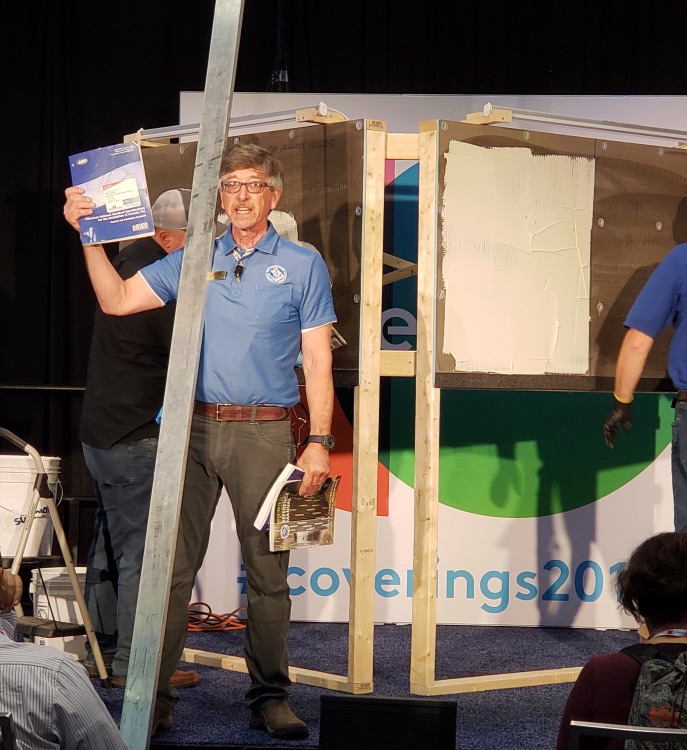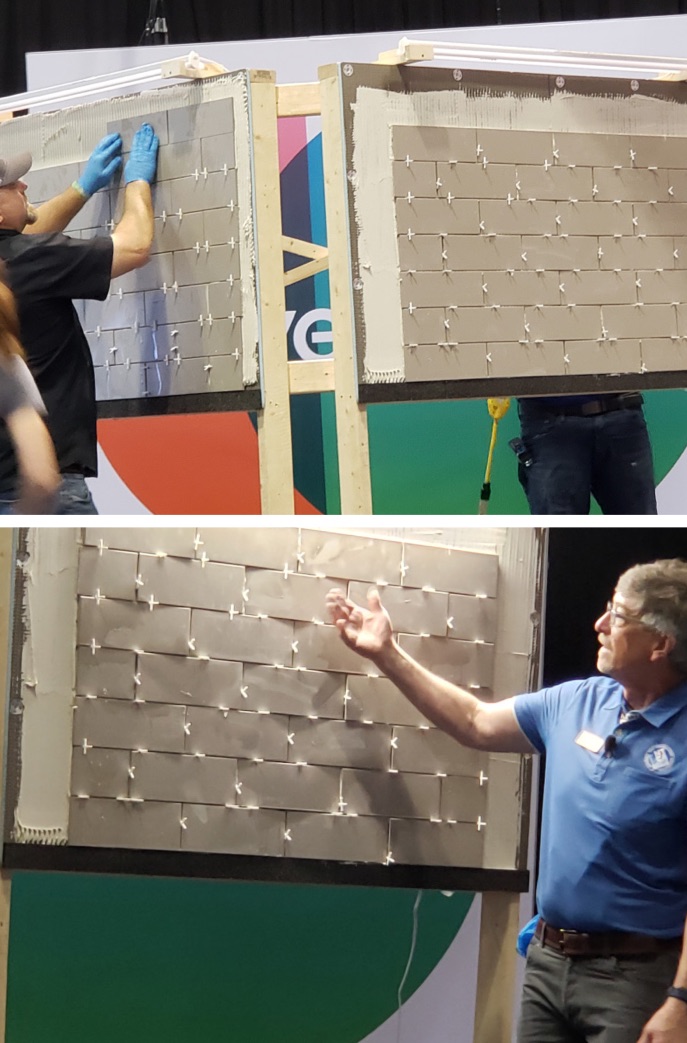QUESTION
Greetings! I was wondering if you could solve a mystery for me. On numerous jobs, for both walls and floors, we are asked by interior designers to install 12 x 24 or similar tiles in a standard brick aka 50% offset pattern. However, for many of these, printed on the box of tile or stated on the order sheet by the distributor, it clearly states in one way or another, “Brick joint pattern to be offset 33%.” When we point this out, the designer doesn’t care and won’t approve a mockup (because they don’t want to order any extra tile). Most of the time the 50% offset on the floor doesn’t end up becoming a lippage or shadowing problem, though we also use a leveling system so perhaps that helps mitigate it. On walls, however, especially depending on the lighting, it can be a real problem.
I would like to know why manufacturers recommend this if it often isn’t followed (I see plenty of tile jobs installed with the 50% offset)? And why do most of the distributors display the tile on a display board with 50% offset if the manufacturer requests a 33% offset? Is everyone just trying to cover their butts on potential lippage and/or shadowing issues? And since tile setters are “the experts,” not designers or customers, is a mockup the only true way to relieve yourself of culpability if shadowing and lippage do result from disregarding a manufacturer’s recommendations?
ANSWER
Thanks for getting in touch and thanks for asking an excellent question.


It is my guess that the designers you are working with may not be familiar with the requirements of tile industry standards and the reason why those standards exist and why manufacturers require certain offsets for tiles they produce.
Listed below are the tile industry installation standards that relate to this discussion:
- ANSI A108.02 section 4.3.7 – Lippage – Guidelines, Explanation, and Caution
- ANSI A108.02 section 4.3.8 – Grout Joint Size
- ANSI A108.02 section 4.3.8.1 – Running Bond / Brick Joint Patterns
- ANSI A108.02 section 4.3.8.2 Running Bond / Brick Joint and Any Offset Pattern (for your convenience, I have quoted this section here):
As you can see, ANSI A108.02 4.3.8.2 is very clear. When this requirement is followed along with installing tile that meets the manufacturing standards of ANSI A137.1 and when the substrate flatness standard for tiles with at least one edge 15” or longer is applied, the correct mortar is selected and mixed properly, the correct trowel is selected and used properly by an adequately trained and skilled installer, a successful finished installation should occur. (Note: the substrate flatness requirement for a 12” x 24” tile only allows a maximum permissible variation of 1/8” in 10’ from plane with no more than 1/16” variation in 24” when measured from the high points in the surface.)


Allow me to state this another way:
- Using tile that meets the requirements of ANSI A137.1 for Nominal Size, Caliber Range, Warpage and Wedging
- Installing that tile on a substrate that meets the ANSI A108 requirements for flatness
- Following the ANSI A108.02 4.3.8.2 and/or the tile manufacturer’s requirements for maximum offset
- Following the details of the appropriate method selected from the TCNA Handbook for Ceramic, Glass, and Stone Tile Installation
- Selecting the correct mortar or adhesive for the type of tile being installed and application it is to be installed in
- Mixing the mortar or adhesive per its manufacturer’s instructions
- Selecting the correct trowel and using it correctly to achieve the bond coat coverage rates required for the system equals a successful, long-lasting installation that will please the owner and end user.
Note that ANSI A108.02 4.3.8.2 states “…specifier and owner must approve the mockup and lippage.” In my opinion, the expense of purchasing an adequate percentage of tile to install the required offsets can be very minimal when weighed against the potential for lippage and lighting-related failures that can occur when manufacturer instructions and tile industry standards are not followed.
Industry standards and manufacturer recommendations of 33% or less offset for tiles with one or more sides 15” or greater are required because of the manufacturing process for tile. When ceramic tile is heated and cooled in the kiln, warpage can occur. This is a normal result of the manufacturing process. Many tile factories are excellent at controlling warpage, but it cannot be completely removed. That is why there are limits for how much warpage a tile can have detailed in ANSI A137.1 for tiles that are manufactured to meet that standard. Whether or not a given tile meets the warpage limit of ANSI 137.1 can be found in the information printed on the carton or on the manufacturer’s technical data sheet, or by contacting the manufacturer.


You are absolutely correct in noting that lippage resulting from a layout or offset pattern or other factors can become a real problem when the lights are turned on. This is especially true for walls when the lighting grazes the face of the wall or when there is a sharp angle of incidence from natural light on a floor. I have listed references on the following page for more information on this topic.
You are also correct in noting that lippage tuning devices can help mitigate these issues. The job of these devices is NOT to take the place of any of the standard requirements I described above, but they can be a useful tool to help installers remove the last bit of human error (typically a maximum allowed 1/32”) and to hold the tiles in place while the bond coat cures. I have listed references below for more information about these devices.
I do not know why manufacturers or distributors might show tiles in an offset pattern that is different than what is required for a specific tile or by industry standards. It could be oversight or lack of knowledge by the person designing or creating the mockups.
You are correct that it very often falls to the tile installation contractor and installer to be the industry expert that understands everything I have described above. The installing contractor and the installer are the last line of quality control before the installation goes in. When or if there is a problem after installation, it is the installer and installation contractor that gets the call. The installation contractor needs to have an excellent working knowledge of the industry standards, methods and best practices to be able to adequately communicate the potential issues during the bidding process and BEFORE the installation takes place. To avoid issues, contractors and installers should empower themselves with this knowledge and know how to identify problems and to stop and identify a resolution before proceeding with the installation. Other trades and professionals such as general contractors, architects, specifiers and designers will respect a knowledgeable tile contractor that is able to clearly communicate what must be accomplished and why. Mockups are a key element of this process and are strongly recommended.
I described the key elements of the ANSI standards that pertain to this discussion of your questions. In addition, there are several other key areas you can use to inform yourself and communicate to other about this subject. They include:
- 2018/2019 NTCA Reference Manual section on Critical Lighting Effects on Tile Installations on pages 125 – 132.
- 2018/2019 NTCA Reference Manual section on Lippage Control Devices and Edge and Lippage Mechanical Tuning Devices on page 172.
- 2018 TCNA Handbook section on Substrate Requirements. See the section on Substrate Tolerances and Large Tile on page 31.
- 2018 TCNA Handbook section on Lighting and Tile Installations on page 34.
- 2018 TCNA Handbook section on Flatness and Lippage on page 36.
- 2018 TCNA Handbook section on Grout Joint Size, Layouts, and Patterns on pages 37-38.
- 2018 TCNA Handbook section on Finished Tilework on page 39 (especially the section on “Visual Inspection of Tilework”)
I encourage you to read and become familiar with all of the standards, methods and best practices I’ve described above in your NTCA Reference Manual, TCNA Handbook and ANSI standards. This will help you be even more confident in describing why installation standards and manufacturer instructions must be followed. Any deviation outside of following them often becomes risk accepted by the installation contractor because at the beginning, middle and end of every job, the tile contractor is the industry expert.
As you and I know, tile isn’t simple or easy. Sometimes, for very good reasons, we can’t always give the owner or specifier what they think they want. Contractors such as yourself that have access to the NTCA member benefits of technical support and education can better communicate the need to apply recognized industry standards, methods and best practices for successful installations. As you know, membership in the National Tile Contractors Association is a major source for help in understanding the standards and how to apply them and avoid issues BEFORE they happen.
We encourage designers, architects, GCs, and specifiers to attend our many workshops and other education programs, or to become an NTCA member themselves. Please feel free to direct them to our website and calendar of events at www.tile-assn.com and click on the Free Educational Workshops link under Education & Certification on the home page. You are doing a great job in asking the right questions. I hope this helps.


Mark Heinlein
Mark Heinlein is Training Director for the National Tile Contractors Association. He is Certified Tile Installer #1112 and currently a Ceramic Tile Education Foundation evaluator for the Certified Tile Installer program. Heinlein was the owner of Mark Heinlein Surfaces of Negaunee, Michigan.







